SEO Copywriting
The Definitive Guide
Writing content that our beloved Google understands is SEO Copywriting. Nonetheless, that content should also be written in a way that makes people want to read it, share it, and link to it. It’s a tough balance, right?
Relax, because today we’ll show you how to do just that.

Part 1
Before Writing
The first step of the SEO Copywriting process has little to do with, well… writing.
It’s all about setting priorities, setting goals for your content’s performance, and planning properly.
Trust us, you don’t want to skip this phase. Preparation accounts for a full 50% of your copy’s success.
By the time you finish this chapter, you’ll be ready to write content BOTH search engines and human users love.
So let’s dive in.

Table of Contents
Perform Keyword Research
SEO professionals constantly have their work cut out for them with Google occasionally rolling out new algorithm updates.
Thank God, at least one thing has remained pretty much the same: Keyword Research.
What Is Keyword Research?
Keyword research is the process of determining and analyzing the words and phrases people use in search engines, such as Google and Bing. It includes not only finding the keywords you want to rank for, but also the ones you should rank for (what people who want what you offer actually search for).
When done properly, keyword research even uncovers the topics based on which you should be creating content.
An area closely related to keyword research is Competitive Analysis.
Through keyword research you can discover terms your competitors are ranking for that you are not, which may lead to essential insights not only for your SEO strategy but for your overall business too.
(PS. Please don’t drink a shot for every time we use the phrase “keyword research”… Shoot, we did it again.)
Why Is Keyword Research Important?
Did you know that 90.63% of published content gets no traffic from Google?
Do you want to increase the chances of your content being in the other 9.37%?
Then you better start conducting keyword research ASAP.
Keyword research is the one and only way to understand what people are typing into search engines. You need to know this so you don’t create content around topics that nobody cares about.
It also helps figure out the specific terms your target audience is using to solve their problem – as well as the context behind those terms.
So what are the key benefits of conducting keyword research?
- Traffic Growth. The higher you rank in SERPs – the more traffic you attract to your website. That’s what happens once you determine the best-fitting keywords for the content you publish.
- Insight Into Marketing Trends. According to our BFF, Inbound Marketing, we don’t create content around what we assume people are interested in; we create specific content around what we know people want to learn. In other words, our audience is in the driver’s seat.
Efficient keyword research can provide you with insights into present marketing trends, plus it allows you to build your content around relevant topics and keywords your audience is searching for.
- Customer Acquisition. If you publish content that other professionals are looking for, you can meet their needs by creating a CTA that will lead them all the way from the awareness stage to the point of purchase.
By researching keywords for their popularity, search volume, and intent, you can discover the questions your audience wants answers to.
Remember: Keywords are your SEO campaign compass – they provide guidance on where to go and let you know whether or not you’re making progress.
Which Are The Most Important Keyword Metrics?
What exactly makes a keyword valuable?
As search engines become more complex, that question is getting harder and harder to answer.
Choosing keywords that pay off is the end goal, but to do that, you need to know which keyword metrics matter the most.
So let’s get into it.
- Keyword Difficulty – Keyword difficulty is exactly what its name states: a metric used to determine how difficult it is to achieve ranking for a keyword.
Measuring keyword difficulty can help you establish whether or not it’s worth your time (and money) optimizing an organic page for that keyword, or bidding on that keyword in a Google Ads campaign.
- Search Volume (Local & Global) – This metric demonstrates how many times a certain keyword is searched for within a defined time frame, in a specific location.
An important clarification to make is that SV reflects the number of total searches of a keyword rather than the number of unique searches. Yeah, don’t be fooled. If a keyword has a monthly SV of 100, those searches could have been performed by 100 different people, or it could have been 10 people that just searched 10 times each.
- CPC (Cost-Per-Click) – CPC helps you determine the estimated cost advertisers pay for each ad click, and it’s yet another metric you should check before trying to rank for a keyword. You need to know what it’s worth to the competition to jump the queue in SERPs. Yes, even if you aren’t running ads at the given time.
A high CPC indicates that there’s a substantial number of advertisers working to beat the organic results. If the market is influenced by a lot of advertising, it won’t be easy getting your organic results to rank.
- Intent – Keyword intent represents the user’s purpose for the search; it’s what the user is likely to do when searching for a particular phrase.
This metric also helps you satisfy searchers’ needs better by matching your content and landing pages to their intentions.
Golden rule: Unpacking keyword intent should be your first step when diagnosing conversion issues.
Useful Keyword Research Tools
Running the gamut from beginner-focused to highly advanced and ranging from basic (and unhelpful) to extremely valuable, it’s safe to say there’s no shortage of tools designed for keyword research.
When operated right, these tools can streamline your entire SEO workflow. They make it easier to find the correct keywords to target and provide the data you need to actually rank for them.
That is why it’s necessary to choose the right keyword planner tool.
To help, we have gathered our personal favorites (and trust us, we’ve used A LOT):
Target Long-tail Keywords
Read 50 articles, and you’ll find 50 different explanations of what long-tail keywords are. Some define them as phrases consisting of 5 or more words (seriously?)… Others say they convert better, yadda yadda yadda.
What are Long-tail Keywords?
Long-tail Keywords are detailed search queries. They often have considerably lower search volume compared to short, broad keywords, but also much lower competition. So if you arranged your keywords by their search volumes, these would be on the “long tail” end of the search demand curve.
Allow us to demonstrate with a very simple example:
Let’s say you own a bicycle shop and want to sell online. You could aim to rank for terms like “bikes” or “bikes for sale” and end up competing against giants like Amazon. Now, you can imagine how that would go.
What if instead, you intended to rank for a long-tail keyword with specific intent, like “best electric bikes under $800”?
When searching for this, smaller hobbyist sites with weaker backlink profiles show up, indicating that a first-page ranking is much more feasible even for a website with low Domain Authority. As The Beatles would say, with a little help from your friends, which in this instance are quality blog posts, you’d have a very realistic chance to crack Google’s front page for this particular term!
Why Target Long-tail Keywords?
91.8% of all search queries are long-tail keywords, according to Backlinko’s analysis of 306M keywords. That alone is explanation enough.
Just kidding, we’ll elaborate as always:
They have a more targeted search intent. Because of being so broad, head terms often make it difficult to figure out what a user is looking for. Sticking with the above example, if someone searches for “bikes”, how can you know what they’re really searching for? Are they shopping for a stationary bike, a motorcycle, an electric bike, or a mountain bike? Or maybe their intention isn’t to buy at all – they could be looking for someone to repair their bike or seeking out ways to meet other biking lovers. It’s tough to create a page that will satisfy every visitor when the intent is so general.
On the contrary, long-tail keywords include hints that help you limit what the person wants. If they search for “best stationery bikes under $800,” that provides 2 incredibly useful clues already:
- They are interested in buying a stationary bike
- Their budget is $800
What does targeted content achieve?
Targeted Content = More Conversions + Lower Bounce Rates + Higher Time On Page |
This winning formula will make Google go: “Hmm, seems like this page is worthy of ranking”.
They represent a suitable buyer. At the beginning of the customer journey, users start out by searching for broad terms because they’re not sure what they’re looking for. It’s through this research that they start to decide on details and ask more specific questions to help settle on what to purchase.
Someone in the market for a new camera might start out by searching for “best DSLR cameras” (6,600 MSV). After reading some lists comparing the most popular options, let’s suppose that they decide on a frontrunner: the Nikon D850 (FYI, we’re no photography experts). Next step is to search for “Nikon D850 review” (590 MSV). This term may only get 590 searches a month, but at this point, the user has already assessed pricing, compared specs, and picked their favorite product.
Bottom line?
Create Content For All Funnels: TOFU – MOFU – BOFU
No, TOFU – MOFU – BOFU is not a TikTok trend…yet. It’s not an insult either.
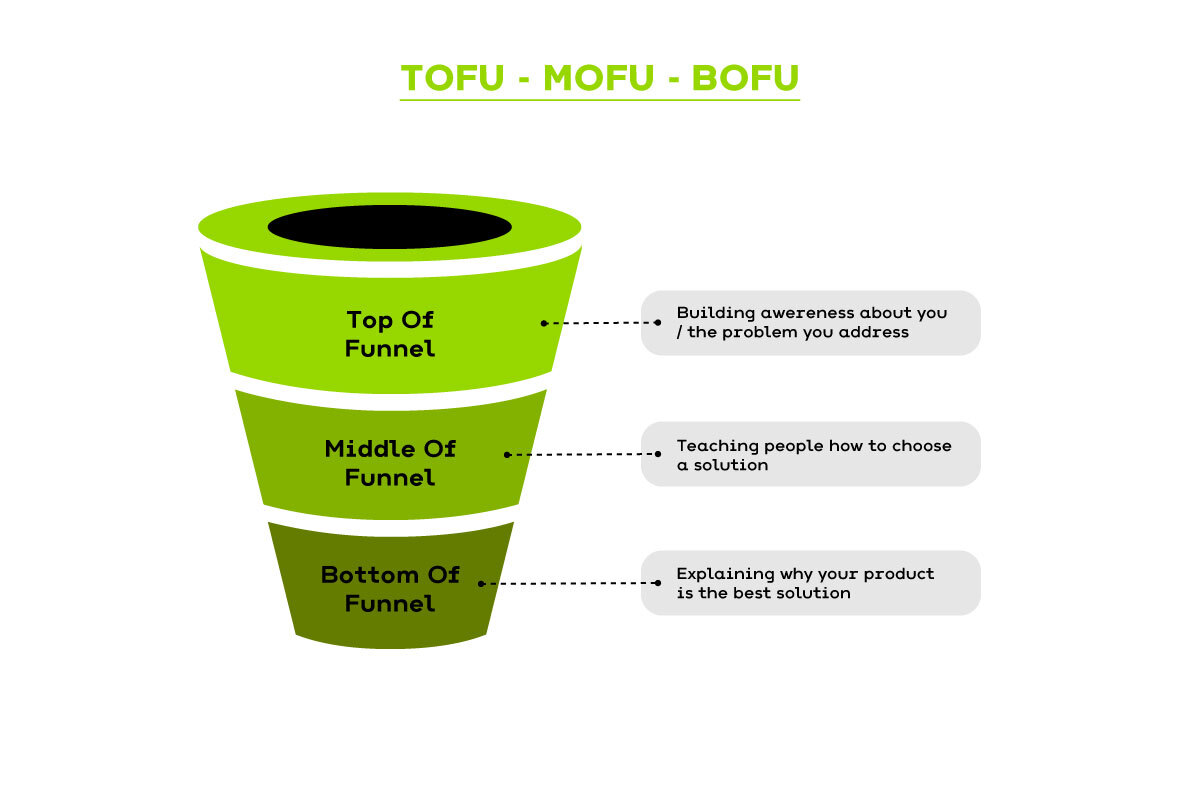
As marketers, we love our acronyms. TofU (Top of Funnel), MofU (Middle of Funnel), and BofU (Bottom of Funnel) are short for a process you’re familiar with: the customer journey.
TOFU (awareness)
Aka the awareness stage. Visitors may not be familiar with your brand or even know what they need. During this research phase, they want answers. That often looks a lot like: “I am facing x problem, and I want a solution.” During this phase, you should provide them with the educational/entertaining content they’re looking for, without adding anything remotely close to a sales pitch. Only introduce your brand as a valuable resource and present your products as a potential solution.
TOFU content examples: Social Media, Blog Posts, eBooks, Infographics.
MOFU (consideration)
At this consideration stage, visitors have accepted they have a problem and are actively looking for a solution, which means you have a narrower target audience. They’re evaluating your brand as one option but considering other solutions as well. MOFU searchers are generally more precise with their Google queries. They know of the solution you offer and are curious to learn more. What are the fors and againsts? Are there any other options they haven’t discovered yet?
In this phase, you’ll need to provide them with as much information as possible in order to decide. Don’t oversell, instead focus on how you are different from the competition and secure their trust in your brand’s expertise and quality. It’s all about encouraging them so that they can move into the decision phase of the customer journey fully prepared.
MOFU content examples: Guides/How-tos, Templates, Case Studies, Whitepapers, Webinars, Videos.
BOFU (decision)
This is your golden stage. Finally, your highly qualified leads are on their way to making a purchase. They are interested in your product, but since they’re probably still comparing, they need a little extra nudge to choose you: extra confidence, extra incentives, and urgency. This phase showcases how your product or service solves their problem and is superior to the competition.
“Shameless” selling is more suitable here, however, we suggest taking an advisory approach to support the lead in deciding. Instead of pushing them to purchase the product, suppose they’re already buying it and help them tailor the purchase to their personal needs. Offer incentives that will make them feel more confident to purchase, like strong warranties and world-class customer support.
BOFU content examples: Product Demos, Comparison Charts, Testimonials, Free Trials.
But Here’s The Catch…
If you are all TOFU // You’ll be educating your audience, but you’ll also be losing out on conversions.
If you are all MOFU // You’ll be restricting yourself to the people aware of the problem you’re solving.
If you are all BOFU// Your content will essentially be a digital brochure.
Search behavior changes as someone moves down the conversion funnel. Therefore, if you don’t optimize your content for each stage, you won’t attract visitors for the full funnel (hence, no money no honey).
Theo Moulos (CEO GrowthRocks) Tweet
Use The Skyscraper Technique
Have trouble drawing your target audience’s attention? Can’t seem to deliver on their expectations? Worry not, because Brian Dean from Backlinko has just the thing for you!
He is the brains behind the Skyscraper Technique, a link-building strategy, according to which you identify high-ranking material with lots of backlinks, locate its weaknesses, and benefit from them to create a far superior piece of content.
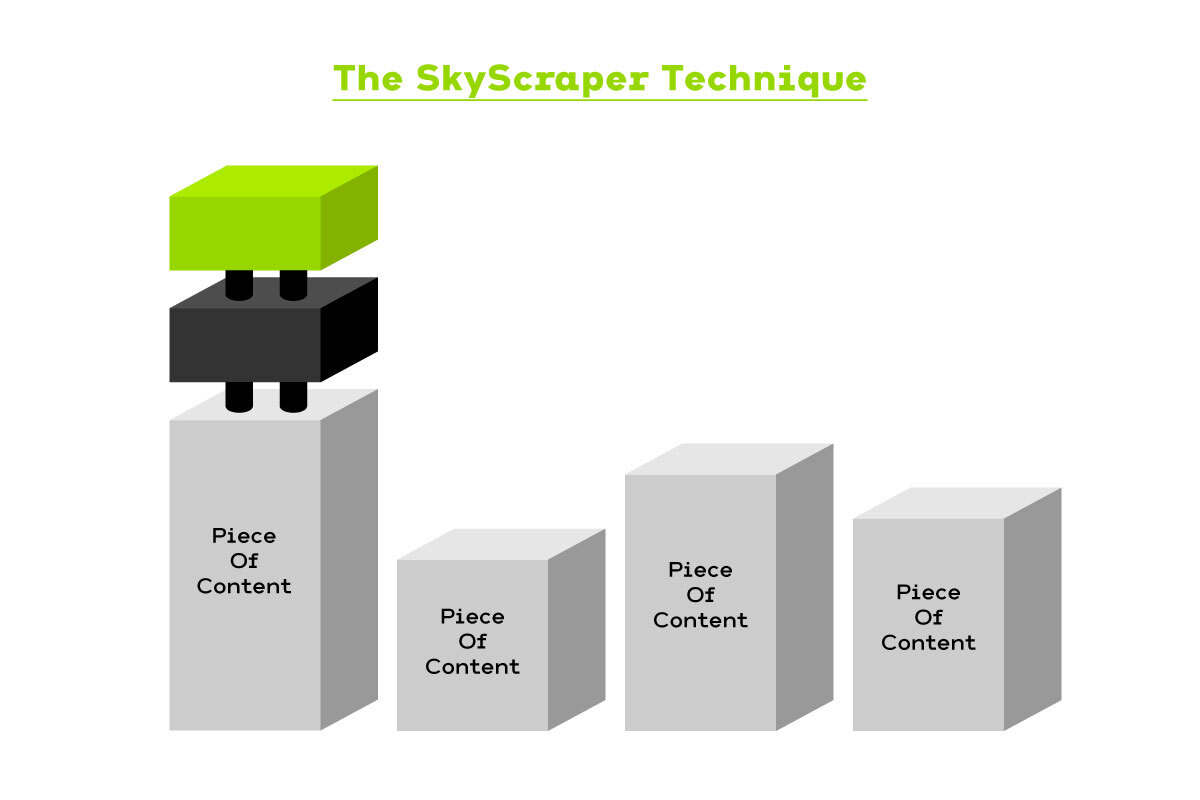
There are 3 core principles to this technique: You start by finding a piece of content in your niche that’s doing well. Then you add value to it in some way, whether that’s adding graphical treatment, adding new layers of information (hence the skyscraper reference, think of layers as floors), or writing a companion piece. Needless to say, give credit where credit’s due. To top it all off, reach out to everyone who shared the original and let them know about your spinoff.
Why does this technique work well?
- You have a prepared audience. You will truly delight the already existing audience if you create something that’s one step ahead of the original piece. As long as the topic is still relevant, we suggest creating a target list of influencers, brands, and publications that either shared or linked to the initial post so you can contact them straight away.
- There’s major potential to rank. Chances are high that Google has already indexed the initial resource. Given that you have created something more valuable than the existing piece, and if you succeed in getting those five-star quality backlinks, you’ll have the chance to “dethrone” that older piece of content and drive in more traffic.
- Demand already exists. Since you’ve already determined that there is demand for this particular topic because of existing content, now it’s crucial to examine why that particular piece did so well. Maybe it provided the readers with entertainment or a solution to a problem? Ask yourself all sorts of questions.
Apply the Hedgehog Concept
An insightful lesson can be learned from Jim Collins’ classic “Good to Great” – and it’s called The Hedgehog Concept (thus the cute, slightly spooky small mammal below).
This concept derives from an old Greek parable: “The fox knows many things, but the hedgehog knows one big thing.”
It easily translates into the business world. Foxes are always changing direction, leaping from one idea to the other. On the contrary, hedgehogs pick a thing and work hard to become the very best at that one thing. According to Jim Collins, that is why hedgehog businesses have a clear market advantage.
So how can you become a “copyhog” and apply this concept to your SEO Copywriting process?
- Identify what you enjoy writing about most.
- Recognize and communicate the one important thing you do better than everyone else.
- Determine what drives leads and generates sustained cash flow and profitability.
The sweet spot is where all 3 overlap (good luck finding it).
Is it optional?
Truth is, if you don’t follow the Hedgehog Concept, sooner or later you’ll just end up writing content nobody cares about.
Part 2
While Writing
In 2022, keywords are still important in SEO.
However:
SEO Copywriting today is far more complex than just adding your target keyphrase X number of times on a page.
In order to rank for keywords with high difficulty and competition, you need to use advanced SEO Copywriting techniques.
Today’s your lucky day, because that’s precisely what we’re going to discuss in this chapter.
Without further ado, let’s get into it.

Table of Contents
Add Bucket Brigades To Boost Time On Page
Have you ever stumbled across a blog post and were absolutely glued to it from start to finish, but couldn’t understand why?
Quick Answer: It’s very possible that you were looking at a piece of content full of Bucket Brigades.
It’s also very possible that you have been using this copywriting tactic all along – and just didn’t know there was a term for it!
Bucket Brigades are words and phrases that essentially “hold” people on your page by keeping the flow and the conversational tone of your copy. They are an old-school copywriting tactic that was originally designed to attract people to sales letters.
Here are a few tried-and-true Bucket Brigade el clasicos:
- Here’s the deal:
- What’s the bottom line?
- You might be wondering:
- This is crazy:
- It gets better/worse:
- Want to know the best part?
But there’s more!
By making use of Bucket Brigades in your SEO Copywriting process, you increase your conversions and keep readers on your page for longer, which can be super helpful in decreasing your bounce rates.
Use LSI Keywords To Make Google Happy
Google used to only look at Keywords – stuffing a blog post with your Primary Keyword proved to be effective. Instead, today Google aims to find the overall topic of a piece of content. So, how does Google know whether your page is about:- Cars the vehicle
- Cars the movie
- The 1970s rock band (with awful hair)
- The Canadian Aviation Regulations (CARs)
The answer? LSI Keywords.
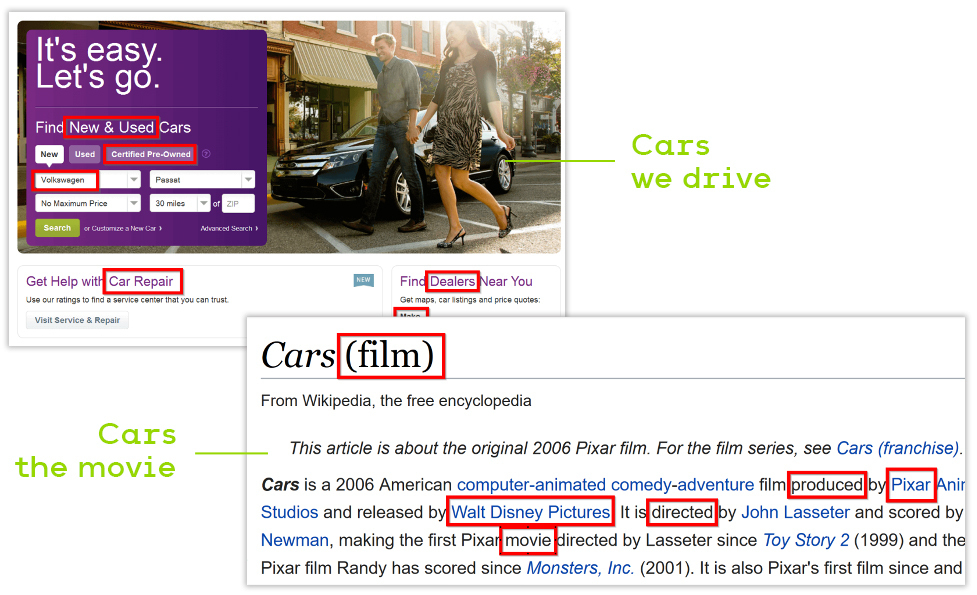
LSI Keywords are a fancy way of saying: “synonyms and closely related words”. Τhese LSI Keywords help Google understand what your page is all about.
Don’t get it twisted though. LSI Keywords are NOT synonyms, they’re terms that are closely tied to your Target Keyword.
For example, take a word like: “jogging”. In this instance, “running” is just a synonym for “jogging”. There’s nothing wrong with using that synonym in your article (in fact, it can help with your on-page SEO). But it’s not an LSI Keyword. LSI Keywords for “jogging” are terms like: “shoes”, “cardio” and “5k”.
Now we come to the million-dollar question: “Where do you find LSI Keywords?” Honestly, finding LSI Keywords is easier than ever. Just search for the Keyword you want to rank for and scroll to the bottom. Google will “serve” you the related searches Keywords:
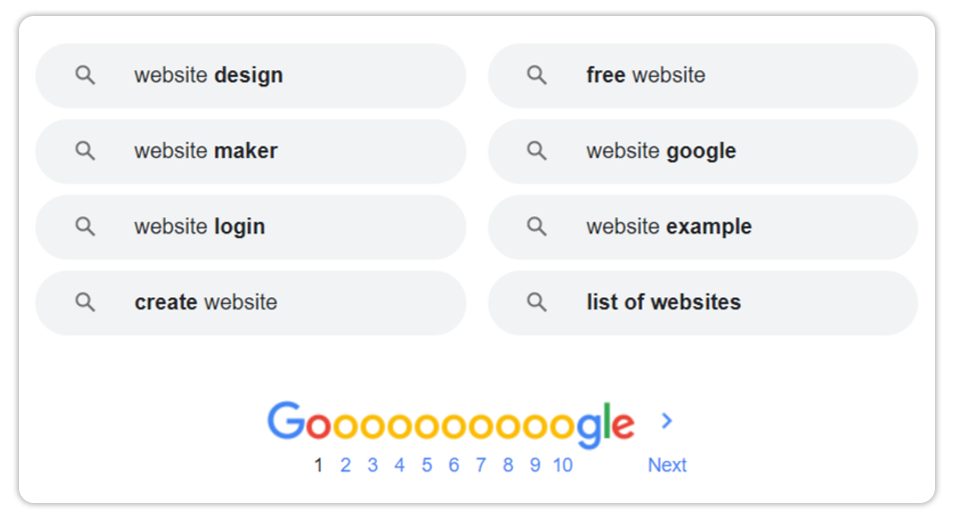
Bottom line?
Speak Your Audience’s Language
Who are you writing for? Do you know your audience’s problems in their industry, the trends that might affect them, or the role they play in their companies? Are you aware of the language they use?
Knowing who you are speaking to is a fundamental part of any type of effective communication. Whether you’re crafting targeted emails, blogs, podcast scripts, or tweets, you need to understand who’s on the receiving end.
If you’re familiar with the niche, you’re good to go. If not, you’ll have to play detective in the communities where your target audience hangs out.
These could be communities like:
- Facebook Groups
- Slack Communities
- Quora
- Forums
By making this a part of your SEO Copywriting strategy, you’ve already taken a huge step toward convincing them that whatever you’re going to ask them to do, is a pretty damn good idea.
Include Both Features And Benefits In Your Copywriting
If you’ve dipped your toes into copywriting before you’ve likely heard that you should: “Sell the benefits, not the features”. Great copy isn’t just about selling, it’s also about building a connection with your audience.
Think about your favorite shirt. It has a specific number of threads keeping everything together, a certain size and a particular gold metal for the buttons.
Those are its features.
But when asked why you adore it, you’re unlikely to respond, “I just love the 30-inch waist, the material of the metal buttons and the cotton thread sewn into the seams”.
Instead, you’d probably say: “It’s so comfortable, it fits really well and I love that it looks good with both plain jeans and suits”.
What’s the Difference Between Benefits And Features?
Features are characteristics of your product that often are explanatory and technical.
Benefits describe how those said features can make your customers’ lives easier.
The quick and dirty answer?
Features are the what, and benefits are the why.
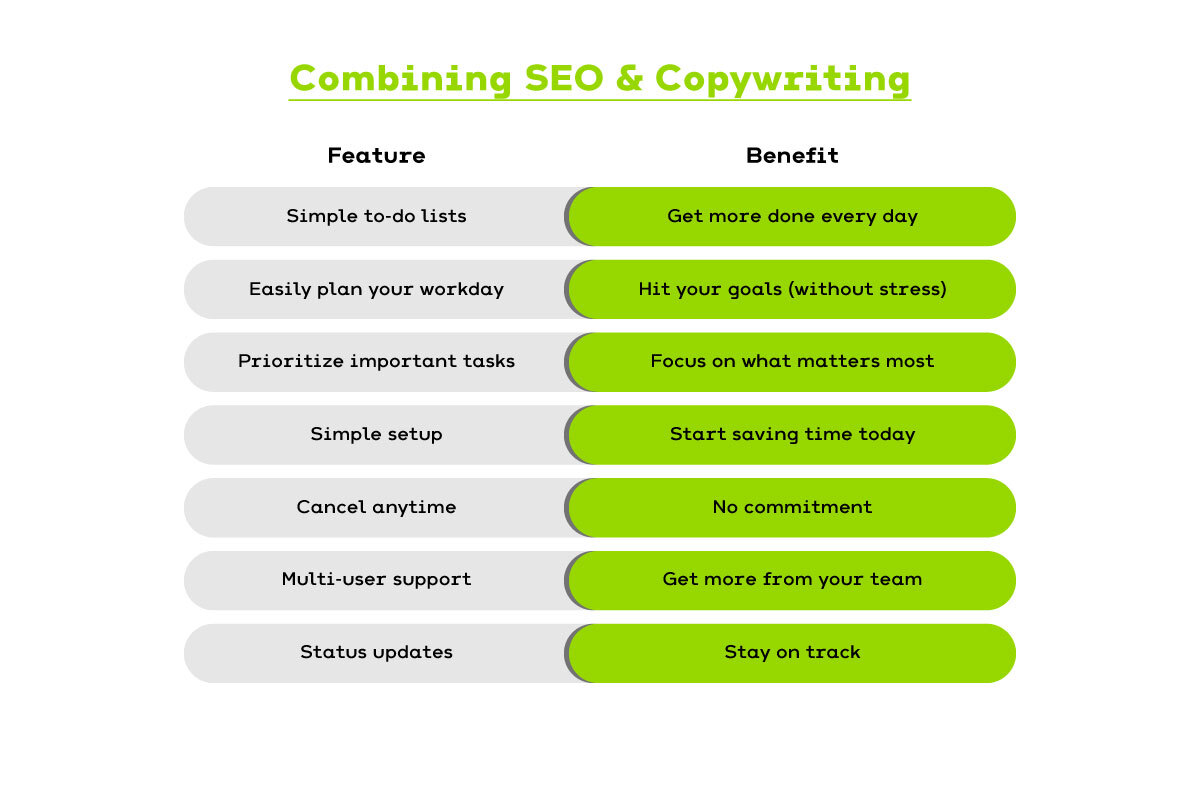
Both are key in providing customers with important information such as design, price, and real-world practicality, but ultimately, the benefits of having a product or service are what drive consumers to purchase.
Why Should You Incorporate Benefits, Not Just Features, In Your Copy?
Benefits are essential because they connect the dots for your customers.
At first, it may seem a little silly laying out all the why’s behind your product features. Won’t customers “just get” why a feature is important?
It’s true, consumers aren’t dumb. What they are, however, is busy and distracted.
So why leave it to chance that they’ll immediately understand the positive impact your product or service will have on their lives?
Don’t suppose your clients will instantly understand why your product features are great. Clearly tell them why by also communicating its awesome benefits.
Use this Intro Formula to Skyrocket Time On Page
Not 10, not 5, but 2 seconds, that’s all the time you’ve got to hook someone on your page. If you lose them in those 2 seconds, you lose them for good.
But how can you get Google readers to stick to your copy like superglue?
The APP Method.
“APP” stands for agree, promise, and preview.
Let’s break it down.
- Agree: You want to start your intro off with an idea or concept that a Google searcher would agree with. Your chances of capturing their attention increase if you show that you understand their problem.
- Promise: Now that you’ve got them aggressively nodding their head in agreement, time for the promise. This is where you explain how you’ll solve their problem.
- Preview: Finally, hit them with the preview. All you have to do is brief your reader on what you have in store for them.
APP Method
Borrow Headline Formulas From BuzzFeed
A fascinating phenomenon in the content marketing and writing world: BuzzFeed. On what other site (let’s exclude Quora and Reddit) would you see these side by side?- People Who’ve Had Workplace Affairs Are Confessing What Happened, And It’s Juicy
- Here’s How To Deal With Health Anxiety, According To Therapists
If Buzzfeed hadn’t nailed the algorithm, this wouldn’t work at all. They’re masters at drawing attention to their content, taking advantage of the curiosity gap, and ensuring clicks on their site. How do they do that? The key is in the headline. Buzzfeed proves that sometimes you don’t need a 2K word count, an unusual subject, or even original content – as long as you have a strong headline, you can soar in traffic.
There are a few qualities all Buzzfeed headlines have in common:
- Most of them include a number.
- They’re particularly casual. The use of “awesome” and other simple language is attractive, especially to younger audiences.
- They’re on the long side. A longer headline grants more room for variety and character.
All of this contributes to making them “content potato chips”. Thin, not much body, but you can’t stop eating once you start. Here are some “clickbait-y” headline formulas from BuzzFeed you can use for your post titles and subheadings.
- 25 ___ That Will Change The Way You ___
- I Tried ___ And Even I Was Surprised About What Happened Next
- This ___ Makes ___ 10x Better
- Here Are 11 ___ That ____. And They’re Backed By Science
- Use These 20 Simple Hacks For More ____. #5 Is Awesome
- When You Learn About ___ You’ll Never ____ Again
Part 3
Supportive Writing Tactics
It’s only fitting that we close out this guide with some of our favorite supportive content tactics.
In this chapter, you’ll discover:
- How to create compelling CTAs
- The most important KPIs to measure your content’s performance
- How to use social proof to increase conversions

Table of Contents
Add CTAs for conversions
Say you’re trying to get more conversions from your blog. You’d probably go crazy with including as many CTAs as you could, right? Yes, and no. You can increase conversions by adding more CTAs on your blog, providing that they’re various types of CTAs, addressing different parts of your funnel.
Before publishing your next blog post, contemplate how your readers can learn more about your company. Which CTAs will urge them to take the next step in their buying journey?
Bottom-of-the-Post Smart CTAs
Do you mean to tell us a visitor has spent 10 minutes reading a full 2k words, for you to not have a CTA at the end of your post? No way Jose.
When deciding which CTAs to use in your blog post, placing one at the very end is probably the most important. After people are done reading your blog, you want them to take action. But not everyone’s at the same stage of the buying journey, so how can you modify what you show to each visitor?
Smart CTAs (they don’t have an IQ of 130, don’t worry). By using Smart CTAs, you can customize your CTA based on who is reading your content. So for a first-time user, your blog’s CTA may be a download link to a free Guide. Accordingly, for someone who is already subscribed to your newsletter list, it could be a “Book your Free Trial” button. Essentially, Smart CTAs help target your audience based on where they are in the buyer’s cycle.
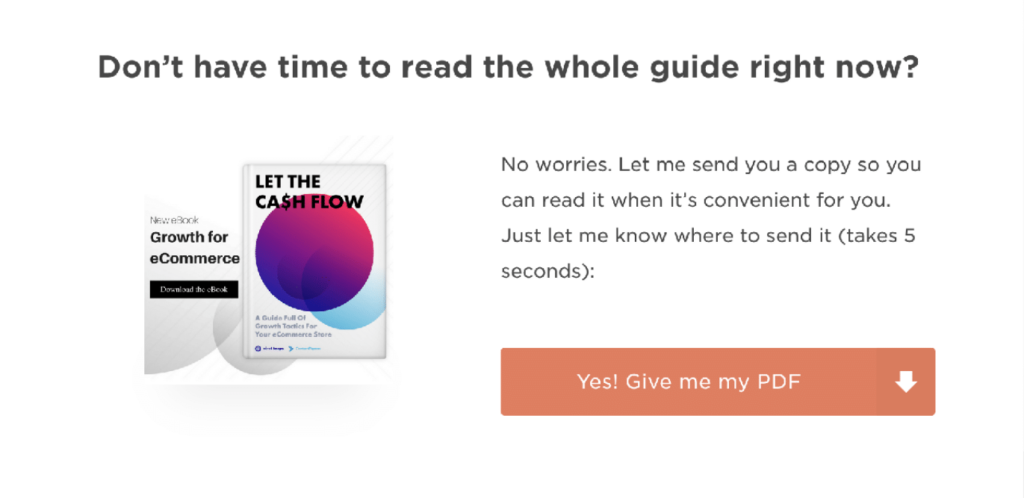
Top-of-the-Post Smart CTAs
If you’re using different types of CTAs in your blog post, place at least one higher up on the page so it’s certain to be seen. We’re all about confidence here, but sorry to break it to you: Not everyone will scroll through the entirety of your content. Capture their attention while you can with an eye-catching button at the top, where most of the readers spend their time.
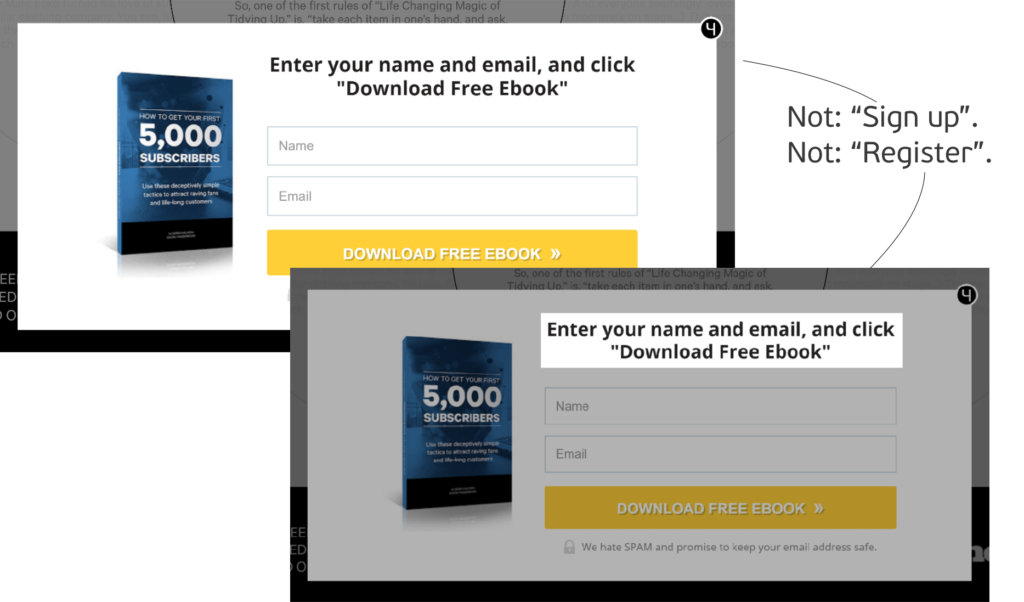
Connect on Social CTAs
If someone’s reading your content, chances are that they will also be interested in future content you post. Make it easy-peasy-lemon-squeezy for readers to follow your social media, by adding a CTA for each one of your profiles. If all it takes is a simple click, they’ll be more likely to do it.
Disclaimer: This and a CTA that allows users to share your content to their personal social media accounts are 2 different things, but both are great tactics to boost your blog content.

Blog Subscription CTAs
Any loyal readers interested in your content will also want to subscribe to your blog by email so they can receive notifications for new posts.
Since the goal here is to grow your subscriber base, you don’t want to turn users off by requiring them to fill in a ton of personal information. Make sure this CTA is a simple form that only asks for their email address. The easier the process, the higher the chances of blog visitors actually filling out the form.

Tweet This CTAs
Dream of your content becoming viral on Twitter? Surely that’s not an everyday occurrence, but what if we told you there’s an easy way for your content to be shared by die-hard fans, website visitors, and employees on their Twitter accounts?
(drum roll…) They are called “Tweet This” links. To put it simply, when someone clicks on this type of link, a pre-created tweet appears promoting the specific content.
This CTA can be great for posts containing snippets of knowledge that are easy to share, like data and infographics – and could help increase your blog’s traffic. Go ahead, try creating one yourself with ClickToTweet.
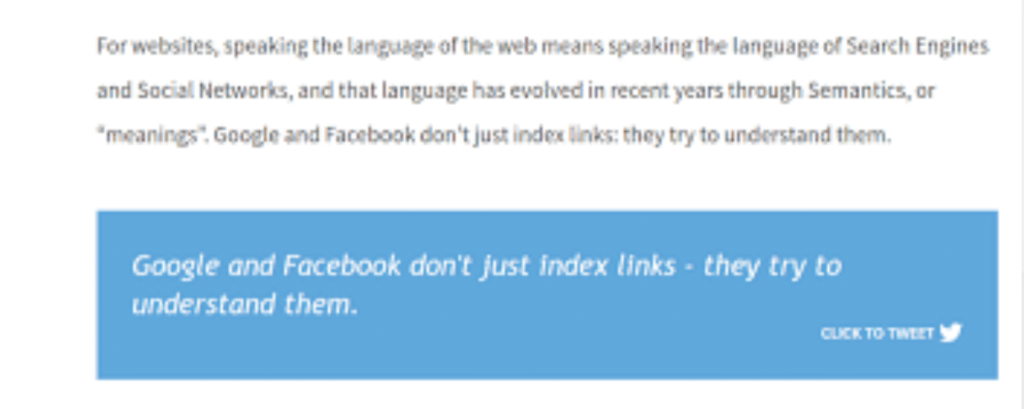
Comment CTAs
If you’re trying to get your audience to engage with your content, try adding a Comment CTA at the end of your blog posts. There’s no link to follow here; you’re just prompting readers to leave their thoughts in the comments below.
You can be chill and phrase it like: “We hope you enjoyed our article! Comment below and share your thoughts on today’s blog post”, or offer even further encouragement by asking them a question based on the topic of your blog.

Slide-In CTAs
As you scroll down GrowthRocks’ blog posts, you’ll notice that a CTA slides in the bottom right corner as you approach the middle of the page.
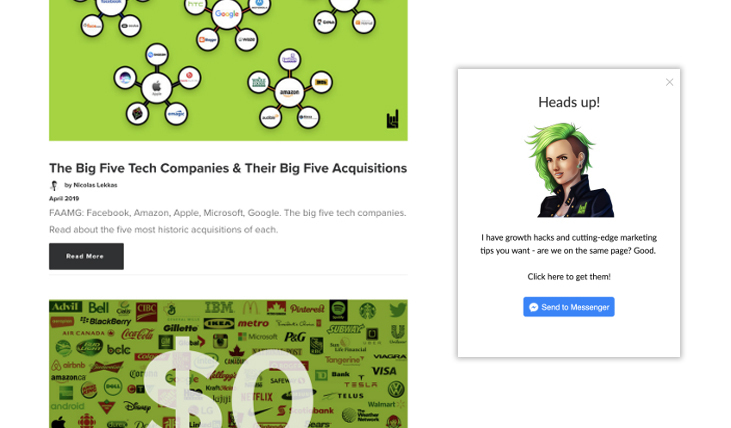
Slide-in CTAs allow your readers to convert, plus they’re not as pushy as an “ignore everything else you do and look at me… I SAID LOOK AT ME” pop-up CTA. Now that’s not a very loveable experience that would make you want to revisit a website. On the contrary, Slide-in CTAs offer additional information to your readers, while simultaneously allowing them to continue reading your blog post.
Cough-cough… Now stop getting jealous over our badass Slide-In CTA, Roxy, and go create your own!
In-Line CTAs
The most underwhelming Call-to-Action in existence. When thinking of a CTA, most of us think of an incredible, amazing, showstopping… (please use your Lady Gaga voice to read this) image, that just pops and instantly grabs your attention. Well, that’s not the only way to utilize CTAs on your blog.
A CTA can also be a link within your blog post that supplies more info on the topic. It functions just like a button CTA, prompting people to take action, the only difference being that one is a hyperlinked button, and the other a written link.
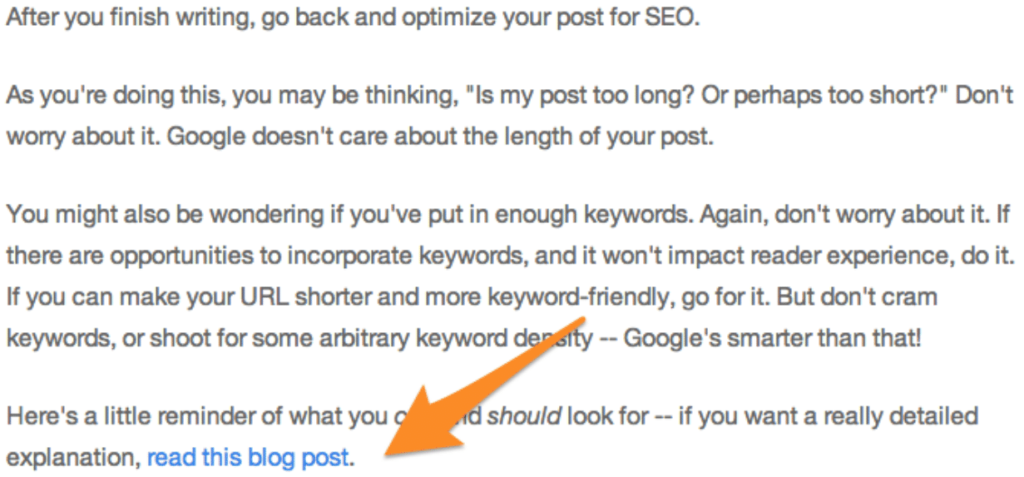
Sidebar CTAs
You have CTAs necessary to drive conversions, CTAs you want to make prominent for content-understanding purposes, and CTAs that may be relevant for your company but don’t add value to the content of your post. The sidebar of your blog is a great place for the latter because they are important to help drive your business goals, but may not be perfectly in sync with your blog’s topic.
Below you see a CTA for GrowthRocks’ Growth Hacking University, which is important for our company but not for the blog post itself – that’s why the sidebar is the perfect place for it.
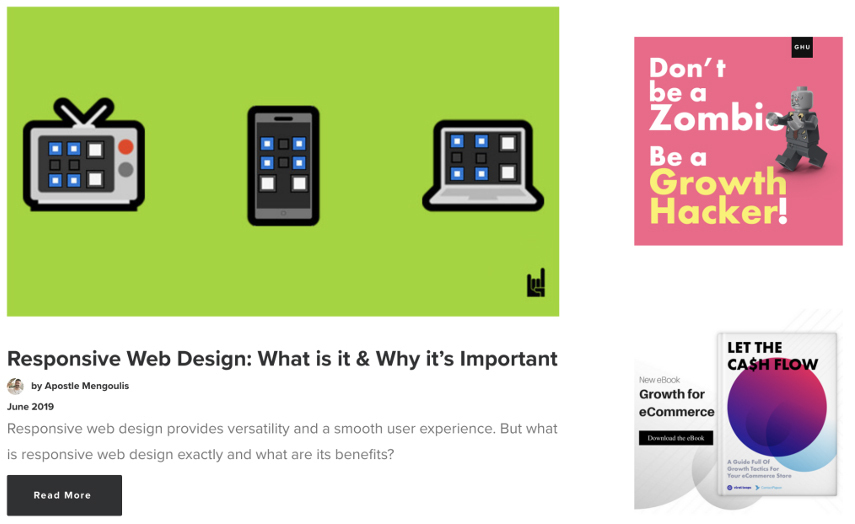
Utilize Social Proof
Say you’re on holiday and you’re searching for a restaurant to eat in. There is a series of factors that help you decide, one of which is looking to see if other people are eating or drinking in a particular establishment. A packed restaurant raises your confidence that the food and service are good, and let’s be honest, there’s more chance of you choosing a bustling place than a downright empty one.
That, ladies and gentlemen, is the psychology of social proof.
There are 6 types of prominent social proof, and you’ll come across at least a couple of them combined (if not all 6) on pretty much every well-staged website:
- Case Studies: Data-driven, extensive analysis of a product or service you provided a specific customer with. Definitely use them when marketing B2B software, agency services, etc.
- Social Media: As the name suggests, social media is a no-brainer when it comes to improving your social proof online. If done correctly, it will help you get through to entirely new audiences without spending a dime on advertising.
- Testimonials: As stated in a Wyzowl survey, 2 out of 3 people say they’d be more likely to make a purchase after watching a testimonial video demonstrating how a business, product, or service had helped a person similar to them.
Important note: Video testimonials ≠ written testimonials
Written testimonials are “meh” compared to video ones; video testimonials are more captivating, they humanize the person sharing their experience, attract the modern video-obsessed consumer, and reveal the emotion and purpose behind someone’s words.
Trust Icons: They are the little logos of companies you’ve worked with that scream social proof, and they work a treat. Simply placing trust icons on your website can increase conversions by as much as 400%. Bloody hell, talk about delivering ROI. They let the world know that you partner with known and highly regarded companies, and that those high-performing companies choose you among the competition.
Reviews: We bet you can’t remember the last time you purchased something without reading a review first. Reviews are similar to testimonials, but they’re usually a bit more in-depth (just think of them as testimonials’ more objective cousin). Use them for products that are too technical or in industries that are crowded and competitive.
Reminder: People aren’t waiting for an invitation to review your product or service. Visit forums and review sites (like Yelp and Google) regularly to be aware of what’s being said about you.
- Numbers: Not all social proof needs to come from your customers. Consider promoting stats that focus on your brand, like:
- Total of active users
- Shares on your blog page
- Number of satisfied customers
Promote these numbers on your website, in email campaigns, digital ads, and social media posts to increase consumer confidence and conversions.
A number can be worth a thousand words. And by combining this type of social proof with another, you’re basically saying “x people bought our product, and here’s how much they’re loving it”.
Check out how Slack uses social proof on their About Us page; who wouldn’t trust a product that 65 of the Fortune 100 companies already use?

Start Your CTAs With Strong Verbs
A verb is a word used to describe an action – and it’s the first word in your CTA (or at least it should be). But what does a strong verb look like? A strong verb is a specific verb that motivates action and gets the point across immediately. More importantly, it communicates worth, not effort, receiving, not giving. Words like submit, start, activate, pay or earn are all action-oriented words. Words like receive, get, view, enjoy, discover or play are also action-oriented. Let’s spot their difference with a very simple example. Let’s say you have created an amazing Inbound Marketing Guide that you want people to download. Which of the following CTAs do you think would convert more?- FREE DOWNLOAD
- DISCOVER HOW TO ATTRACT MORE CUSTOMERS!
Obviously the second CTA would perform far better, and that is because it emphasizes receiving. Always use words that are calls to reward, not calls to effort.
Final Thoughts
By following the above, advanced SEO copywriting techniques and strategies, you’ll be well on your way to creating high-quality content. After publishing, be sure to measure its performance by tracking KPIs like:
- Page Visits
- Bounce Rate
- Inbound Links (i.e. the total number of sites linking to the page)
- Conversions (i.e. the number of page visitors who performed the CTA on the page or responded to the CTA prompt)
- Number of Comments
- Total Number of Social Shares (cumulatively and by channel)
Keep track of the metrics that are more valuable to your business, update existing content as needed, and craft new content to fill the gaps.
As long as you create user-friendly content that answers people’s questions and is based on keyword research, you’ll be a gold mine of helpful content in no time.
Until we meet again, happy writing!


